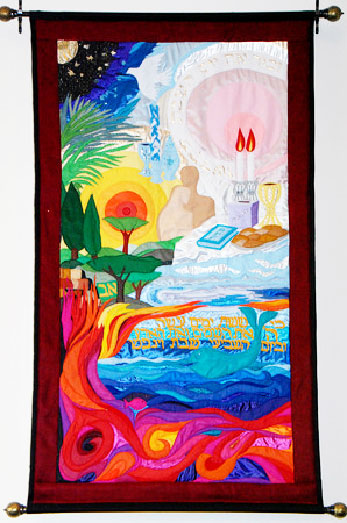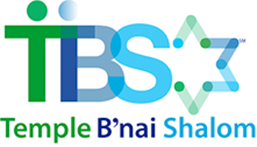Tapestry #11 – Av: The Value of Shabbat in our Lives
 When I went to do Joseph Robert Foosaner’s bris last Friday morning, I arrived to hear his brother, Sam, tell me that he was drinking “Shalom milk.” You may ask, “What on earth is Shalom milk and how can I get some, it sounds so Jewish?!” Well, to teach their son the importance of Shabbat, the Foosaner’s bring Sammy often to services and every Shabbat dinner, he is allowed to have chocolate milk, but just on Shabbat. When his mom hands him the milk, she says, “Shabbat Shalom.” And so, Sam calls his chocolate milk “Shalom milk.”
When I went to do Joseph Robert Foosaner’s bris last Friday morning, I arrived to hear his brother, Sam, tell me that he was drinking “Shalom milk.” You may ask, “What on earth is Shalom milk and how can I get some, it sounds so Jewish?!” Well, to teach their son the importance of Shabbat, the Foosaner’s bring Sammy often to services and every Shabbat dinner, he is allowed to have chocolate milk, but just on Shabbat. When his mom hands him the milk, she says, “Shabbat Shalom.” And so, Sam calls his chocolate milk “Shalom milk.”
My sons were one and two years old when B’nai Shalom started. I dressed them for services every Shabbat in little suits and real shoes. We called their shoes, “Shabbat shoes,” and the name stuck until about the Middle School dances. “Mom, where are my Shabbat shoes?” they would call down as I was preparing our weekly Shabbat dinner. The rule in our house was that Shabbat Happens… everyone was at the Shabbat table every single week, and at services Friday, or Saturday when high school demands set in. It is what we did, and I truly believe that weekly, faithful Shabbat attendance prevents problems with kids and teens, because it brings a family together in a way that sports, TV, and other activities just cannot provide. We had Shabbat dinner every single week and Shabbat tea after coming to temple, and Shabbat lunch whenever possible. Shabbat centered our hectic lives and, to this day, grounds our existence.
My boys are men now, and Shabbat is real in their lives. Each of them call home Shabbat afternoon now that they are away, even when they are in Europe or Israel. They have been to Shabbat services all over the world this year. Jacob is leading services tonight for the Reform Community at Syracuse Hillel, and carries a Havdalah candle in his backpack because he makes Havdalah every week. Jonah spent Shabbat in Germany all summer in the large shul in Berlin and spent his last summer abroad in the nature reserve of Ein Gedi, south of Jerusalem. Last Shabbat morning, all four of us were at Minyan Makers praying and singing, studying Torah, and sharing community. When I teach “Shabbat Happens” and hand out our TBS bumper stickers… I mean it, because I practice what I preach 52 weeks a year.
So, when we were outlining the values of Temple B’nai Shalom that would hang on the walls of our sanctuary, ‘Shabbat Observance’ was so important to all of us that it got its own tapestry, and we are grateful to the Froehlichs for donating this one to our congregation. Shabbat happens at their house too, and for years Rick delivered challah for oneg to our temple on his way home from work.
Shabbat Happens here at B’nai Shalom for more of our members than for most Reform congregations in America. We fill our sanctuary all year round and have gone from 200 to 250 and now to 300 chairs in the sanctuary because we didn’t want to have to open the back walls for Friday services any more. We love when Erev Rosh Hashanah is a Shabbat and we have one TBS service to feel like a family. Week after week during the year, family members of Bar and Bat Mitzvah children come up and tell me that they would come regularly to services if they lived here because our services are so meaningful. Even our podcasts are automatically downloaded weekly by 160 people, in addition to the occasional person who finds us, and shares Shabbat with us in Carlbach fashion… on a Tuesday or Wednesday, or at the beach. Just a few weeks ago, when Jonah was in Israel he met a rabbinic student who recognized his name because he had downloaded our Shabbat services during the period before Tisha B’Av when you can’t listen to music, but can listen to prayer. Shabbat Happens for us, and the value of Shabbat is a powerful reminder of its centrality in our lives here at B’nai Shalom.
The tapestry we are enjoying tonight reflects two aspects of Shabbat – its Biblical origins and our observance today. In Genesis we read, “And there was evening and there was morning, one day.” The left hand corner shows evening and the creation of the moon and the stars. As you travel down the left side of the tapestry, the colors of the rainbow unfold the beauty of the first six days of creation: trees and grass, oceans and rivers, fish and even Jonah’s whale…all created in the Torah and according to the Midrash in the first six days. And then, in the center of the tapestry we see the words of Exodus 31:17 from our beloved V’Shamru prayer: “Ki Sheshet yamim asah Adonai et hashamayim v’et haaretz, uvayom hashevii shavat vayinafash.” — “…for in six days Adonai made the heavens and the earth, and on the seventh day [God] stopped working/rested (shavat) and was refreshed/given new life. We jump up when we sing these words to celebrate the fantastic gift God has given us.
This tapestry is also commemorating the month of Av, the summer month that we concluded this week (I postponed this sermon to talk about Israel when I returned, which explains why this sermon is being given on Rosh Hodesh Elul.). Av is the saddest month in the Jewish calendar, as both temples are said to have been destroyed on the 9th of Av, Tisha B’Av, and many tragic historic events occurred. To commemorate this, we have the word Av on the middle left beside stones of Jerusalem’s 1st and Second temples ablaze with destruction, but artistically quenched by creation’s waters.
On the right side of the tapestry we have the second aspect of how we celebrate Shabbat. Exodus 20:8 “Remember the Sabbath day and keep it holy – Zachor et yom haShabbat l’kadsho.” God gives us Shabbat, but it is up to us to make it holy. We humans make Shabbat holy for God. And so we have our candles and wine and challah sanctifying the day and the joy of Shabbat. After the temple was destroyed, we are taught that the leaders of Israel decreed that no wine or meat would be eaten ever again. The law was rescinded when the people felt it was too great a burden. To this day we hold the cup of wine to consecrate all of our moments of joy, Shabbat being the one that comes most frequently.
We asked our artists, Bracha and Menachem Lavee to add two things important to B’nai Shalom to the Shabbat table. We are a praying congregation on Shabbat, so we added our blue Gates of Prayer upon which it says siddur, prayerbook in Hebrew. And we added a tzedakah box to show that the giving of tzedakah before Shabbat is important to us, and to make sure that at least one of our tapestries specifically included tzedakah.
The observance of Shabbat keeps us whole. The root of Shalom/Peace isshalem/wholeness. When we conclude our service we say Shabbat Shalom. The dove of peace on our tapestry is more important right now in Israel than when our Israeli artists designed and sewed the dove. May Israel know a lasting peace from household to household, soon and forever.
We added one other thing… Havdalah. God separated the light from the darkness, the waters to make heaven and seas, and we are commanded to separate the sacred Shabbat from the secular work week. At Shabbat’s end we bid farewell to the rest and sense of peace, and prepare to take Shabbat with us into the week with the ceremony of Havdalah. The three-dimensional braided candle reminds us how our lives are intertwined with one another, and with our tradition. The fragrant spices entice our sense of smell, as we utilize every God-given sense to experience Shabbat, and to fully appreciate our world. And the wine, as always, consecrates the moment of transition – in this case moving from sacred to mundane, although most times helping us move from the sordid to the sacred. Coming from the Havdalah candle is the dove of peace teaching us that Shabbat helps bring peace to our lives, our family, and our community. At the center is the man and woman of the sixth day of creation, or Adam and Eve…take your pick. Shabbat is nothing without US. We are the witnesses and observers. Jews make Shabbat. It doesn’t happen without us:We light. We bless. We taste. We smell. We feel. We touch. We sing. We pray. Westudy. We reflect. We rest. We rest because God rested, and because without rest we would lose something profoundly sacred in our souls. Shabbat keeps us human and makes us whole in a way nothing else can do. We are even commanded to give rest to our animals and servants. Every life needs to be refreshed. Our world without Shabbat gives rise to increased stress and burn out, illness and family disfunction. Shabbat is the first thing I recommend when lives are falling apart.
ZACHOR –“Remember the Shabbat” says our tapestry and our Torah. How blessed we are that we can remember together in this beautifully renovated sanctuary.
I began this sermon series last Elul with Tapestry #12, and we had an auf ruf, a pre-wedding blessing to celebrate that tapestry dedicated to love. Av has one other holiday, a newer one, that Rabbi Nyer teaches about often called Tu B’Av. According to the Jewish Week it is the Jewish Valentine’s Day. So how beautiful and fitting that tonight we conclude this sermon series with a celebration of that holiday and love as we will have the privilege of blessing Rabbi Nyer and her fiancé, the incomparable Stephen here on the bimah, on their engagement this week. We pray that their lives will be rich with love and happiness from Shabbat to Shabbat as they celebrate together and with all of us.
As I conclude this twelve sermon series I say the words we use each time we conclude a book of Torah, “Chazak, chazak v’nitchazek” — may we come into this sanctuary when we need strength, may we come when we have strength to give, and may the beauty of this sanctuary and the sacred Shabbatot and festivals, life cycles and special moments enable us all to strengthen one another. May Shabbat bless your lives with the beauty reflected in this tapestry, and may this synagogue’s sanctuary enable you to truly treasure what it means to be B’nai Shalom.
Shabbat Shalom.
